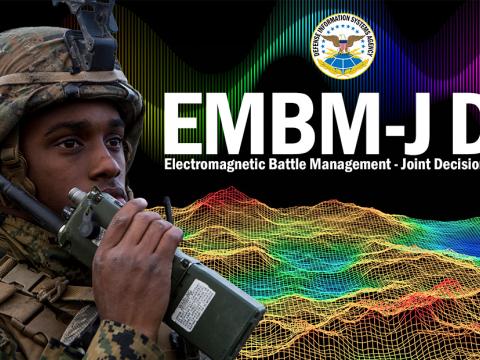Extraterrestrial System Sharpens Tactical Eyes on the Ground
Satellite network provides over-the-horizon voice, data nets to warfighters on the move.
Ask any small unit deployed in theater, and troops will say their number one communications challenge is obtaining ready access to reliable, real-time voice and data connectivity. An innovative satellite-based tactical communications system featuring a unique multicast one-to-many architecture is helping warfighters solve that problem, and it works virtually anywhere, including the challenging terrain of
Maintaining continuous voice and data communications for company, platoon and squad-size units in
Over the past two years, the U.S. Naval Surface Warfare Center (NSWC) in
Also known as “Netted Iridium,” the DTCS was designed around Iridium’s constellation of 66 low-earth-orbit (LEO) cross-linked satellites and a commercial off-the-shelf, push-to-talk handheld satellite transceiver that has been modified and ruggedized to hold up in harsh all-weather combat environmental conditions. In June, the NSWC awarded Iridium’s government programs subsidiary a $21.6 million contract to expand the capabilities of the DTCS.
NSWC civilian engineers, with a continuous presence in theater since fall 2008, have been working with
Iridium’s polar orbiting cross-linked satellites provide voice and data connectivity anywhere in the world, including areas where geostationary satellites or line-of-sight communications systems do not have coverage or cannot function. Troops operating in deep valleys, for example, often are unable to transmit or receive over geostationary satellites because mountains block the fixed-look angles.
Unless forces move to higher ground, where they could point and adjust a deployable antenna to access a signal, they are unable to communicate via satellite. With Iridium’s LEO constellation, however, the satellites constantly are traveling overhead at approximately 17,000 miles per hour, and even in mountainous terrain, user location is seldom an issue. In a dramatic satellite communications paradigm shift, the satellite asset finds the troops, not the other way around. With the DTCS, if warfighters can see the sky, they have communications.
The “netted” aspect of the DTCS represents a significant operational breakthrough. Iridium’s satellite infrastructure originally was designed as a global telephone network supporting only point-to-point connections. Early Iridium model 9500 satellite telephones provided only voice and mobile-terminated short message service (SMS) capabilities. Later models of Iridium telephones—including some Model 9505, Model 9505A and current 9555 handsets—support both mobile-originated and mobile-terminated SMS services. With in-orbit software changes to the satellites and hardware upgrades to Iridium’s land-based infrastructure, the DTCS now uses Iridium to provide an efficient, multicast architecture that supports tactical communications while dramatically conserving network resources. With the DTCS, a warfighter can talk or send narrowband data files such as small text files, and even chat with many listeners over a common channel within designated, established, managed and controlled user “nets.” This arrangement has little impact on the many users who continue to employ the constellation for conventional point-to-point satellite calls.
Operating in the L-band for user access, the system currently supports 250 unique nets—each with its own encryption and security keys—and offers reliable coverage of 100 miles for users within a net. Under a contract awarded in June, Boeing, which manages Iridium’s satellite constellation, is overseeing software upgrades that will create as many as 16,000 user nets with an expanded range of up to 250 miles. That will satisfy typical tactical communications needs of small units that otherwise might not receive the information they need because they lack access to other systems and networks. Because of its efficient architecture, the DTCS supports an effectively unlimited number of users within those nets.
For the warfighter, the DTCS offers the advantage of simplicity. The handheld device has one knob for volume, one knob to select channels and a push-to-talk button. The system operates much like a trunk-based radio, in which a pool of users shares a number of frequencies. Individual nets on the DTCS can be assigned prior to a mission, often based on specific tasks, such as nets for command and control, medical evacuation and fire support. Users in each net are assigned a channel number. In some cases, a user can belong to more than one net, and the radio will scan for traffic on the primary and secondary nets to which a user has been granted access.
Warfighters in the field do not have to worry about ground infrastructure. Calls go directly through the satellite to the other transceivers on the net without touching the ground. Callers do not have to dial in a specific frequency or request a channel or time slot. All they do is select the net (channel) they need. When a user pushes the talk button, the Iridium network automatically assigns a frequency based on availability and instantaneously alerts other users in the net of the frequency assignment for that session.
NSWC Dahlgren is coordinating with the National Security Agency on ways to enhance protection of voice and data communications while preserving the ability to share information across military communities, including coalition forces in theater.
Users can plug the current fielded handheld device into a laptop to download data and send the information to a command post. ITT is leading efforts to develop a more advanced DTCS radio, called the C2, which will include a built-in personal digital assistant, giving users a handheld Web-based computer capability to receive and transmit data.
The DTCS began as an industry-funded cooperative research and development agreement between Iridium and the U.S. Marine Corps Warfighting Lab in
To hold down development and life cycle costs, the DTCS handset is built with many off-the-shelf components. CR123 lithium batteries—a common supply item used for military flashlights, night vision goggles and other equipment—power the satellite transceiver. Further, the device is compatible with H250 tactical handsets, one of the most common in the field. It can be installed easily in up-armored vehicles and quickly removed. The handset also is being tested in medevac and troop transport helicopters.
As the DTCS evolves, voice communications likely will remain the top priority for deployed forces. But a significant data capability provided by the DTCS is troop position locator information (PLI). Every time a user pushes to talk, the system allows each handset to display the position of not only that user, but of other members of the selected network. The system has the capability to transmit PLI data from net users to the secure Defense Department Iridium gateway in
Other user feedback on the DTCS has been equally encouraging. In
Before taking the system into the combat zone, NSWC Dahlgren partnered with the Marine Corps Mountain Warfare Training Center in
Leaders within Central Command also have been impressed. Brig. Gen. Mark Bowman,
For the dismounted warfighter, the DTCS is providing a capacity and a capability that is in high demand and typically reserved for high-priority users in
Brig. Gen. Bernard K. Skoch, USAF (Ret.), is former director of communications operations at
WEB RESOURCE
Iridium: www.iridium.com




Comments